
Various diseased human body parts from hearts, lungs and kidneys all on display. — Picture by Firdaus Latif
Planning your holiday getaway? Invest RM100 with Versa & grab RM10 FREE to kickstart your travel fund. Use VERSAMM10 now!
By R. Loheswar
Saturday, 17 May 2025 7:00 AM MYT
- Universiti Malaya's Tan Sri Lim Wee Chai Medical Museum provides a starkly educational view of human anatomy and disease through preserved specimens for public and student learning.
- The museum, named after a key donor, highlights both medical history and the donor's philosophy of health and societal contribution.
- Presenting normal and diseased specimens together, the museum aims to foster holistic understanding and empower individuals to make informed health choices.
KUALA LUMPUR, May 17 — The first thing that greets you is a haunting sight: a pair of infant twins suspended in glass, locked in a permanent embrace.
Preserved in perfect stillness, the two infants float in their glass case with tiny arms wrapped around each other. Their chest is dissected, revealing the intricate web of organs beneath translucent skin.
This is no ordinary museum exhibit. These are conjoined twins, separated only in death, now serving as an unforgettable introduction to Universiti Malaya’s Tan Sri Lim Wee Chai Medical Museum.
This intimate glimpse into tragedy becomes the entry point to a broader, unfiltered journey into medical science.
This singular exhibit sets the tone for the rest of the museum — a place where science meets history and education in an eye-opening experience.
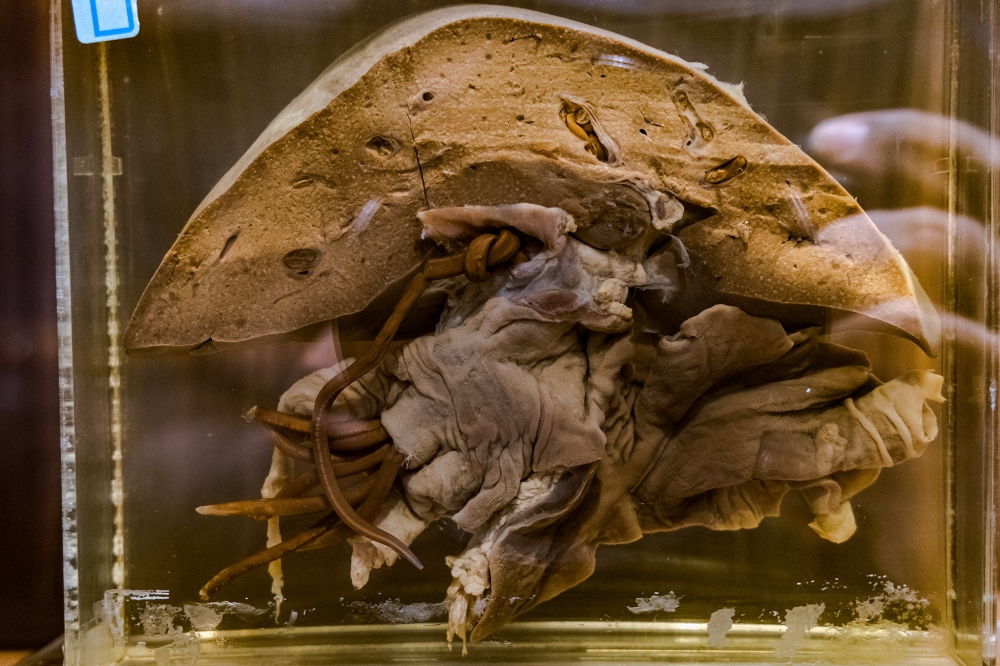
Ascaris lumbricoides infestation in a child's liver. This worm is the most common found in humans. This is one of the rarest pieces. — Picture by Firdaus Latif
Tucked within UM’s medical faculty, this is Malaysia’s only open collection of diseased human specimens. It offers a rare opportunity for the public to confront the fragile reality of our bodies.
From cancerous tumours to parasitic infestations, from malformed foetuses to organs ravaged by syphilis, the museum presents medicine’s most profound lessons without filters.
Visitors may view preserved organs ravaged by cancer, lungs damaged by illness, and hearts destroyed by syphilis. There are also preserved foetuses at various stages of development, showing the intricate process of human gestation.
As visitors move past the conjoined twins, they encounter a historical video documenting Malaysia’s first successful conjoined twin separation surgery, performed at Hospital Kuala Lumpur in 1967. This pioneering procedure marked a milestone in the country’s medical history.
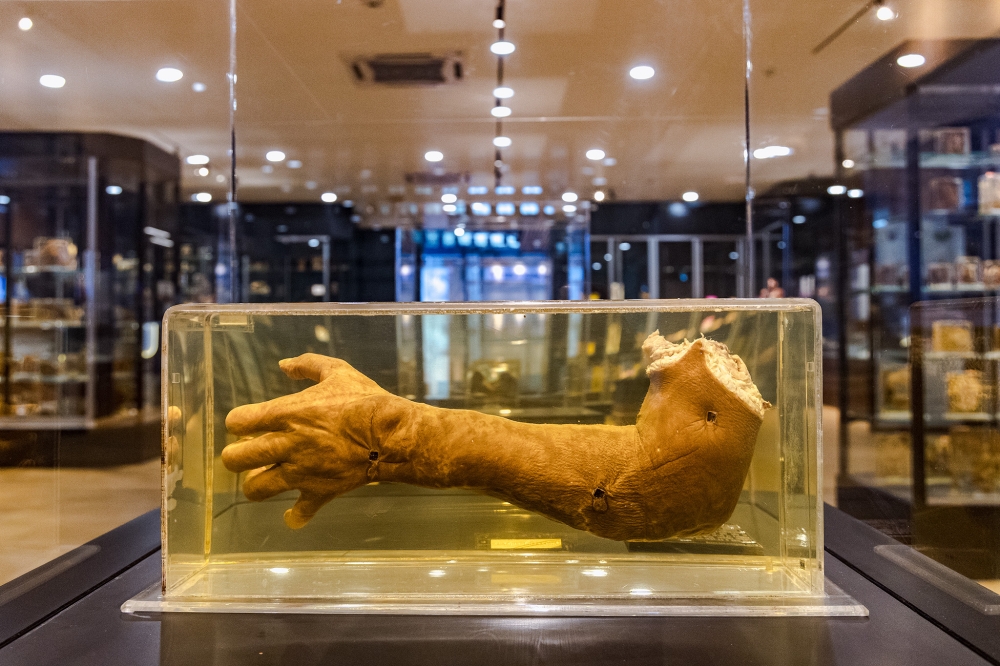
A hand preserved in Kaiserling solution to preserve and stabilise tissue specimens. — Picture by Firdaus Latif
Rare and fascinating specimens
The museum is home to an array of rare and striking exhibits, including:
- Congenital Diaphragmatic Hernia (CDH) Infant — A preserved specimen of a baby with a hole in the diaphragm, allowing internal organs to push into the chest cavity, compressing the lungs and shifting the heart to the right.
- Sirenomelia (Mermaid Syndrome) Baby — A foetus with fused legs, a rare and often fatal congenital disorder.
- Anencephaly Specimen — A baby born without parts of the brain and skull, showcasing the devastating effects of neural tube defects.
- A Liver Infested with Worms — One of the rarest specimens in the collection, featuring the remains of parasitic worms that had consumed a man’s liver.
- A Heart Destroyed by Syphilis — A shocking display of how untreated venereal disease can devastate the body.
- A Massive Ovarian Tumour — A large, preserved tumour, including one removed from a child.
- Horseshoe Kidney — A congenital condition where the kidneys are fused together, forming a U-shape.
There is a full-time curator, Rizqullah Bariq Azmi, who is knowledgeable and affable, ready to answer any question.
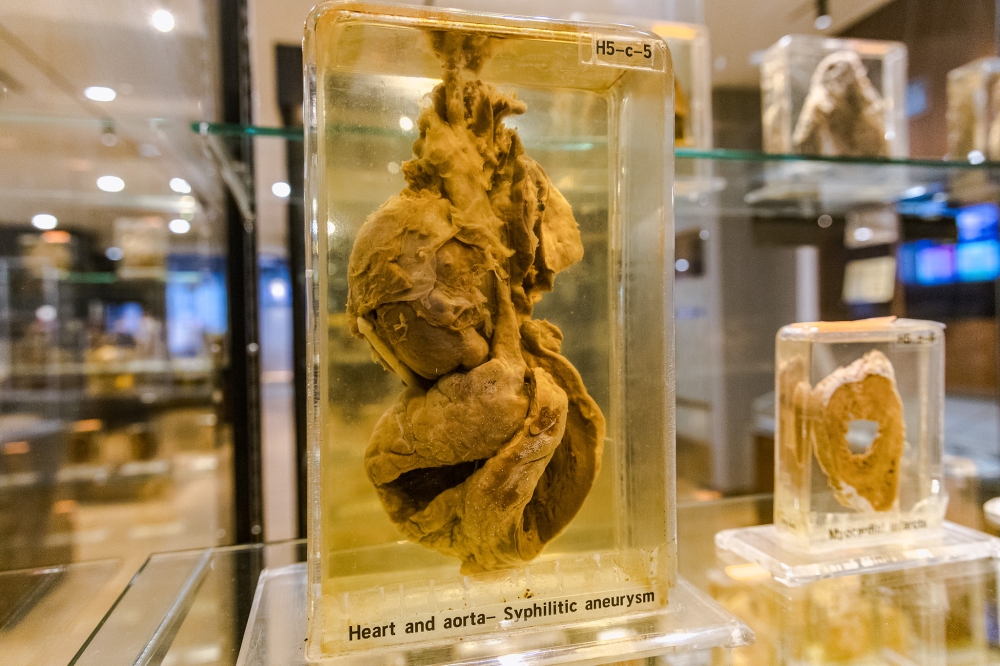
A heart infested with syphilis causing aneurysms in the aorta. — Picture by Firdaus Latif
“This is a unique specimen of a heart and liver that have been eaten by worms. You can actually see the dead worms inside. This is one of the more unusual pieces.
“We also have a heart that belonged to someone with syphilis. The infection caused severe swelling and damage and you can clearly see the heart destroyed. We also have a seminoma of the testes, a tumour that completely replaced the testicle. You’ll see it cut open in different sizes,” he said as he took Malay Mail around the museum.
Tan Sri Lim Wee Chai is the founder and executive chairman of Top Glove Corporation Bhd. He donated RM2 million for this project and expressed gratitude for his personal and professional growth, attributing much of it to his time at Universiti Malaya.
As an alumnus, he sees it as both a privilege and a duty to give back to the institution that shaped him.
He stressed the importance of education in driving progress and believes in supporting institutions that nurture future leaders.
Having the medical museum named after him is a great honour, and he hopes it will inspire and benefit generations of students to come.
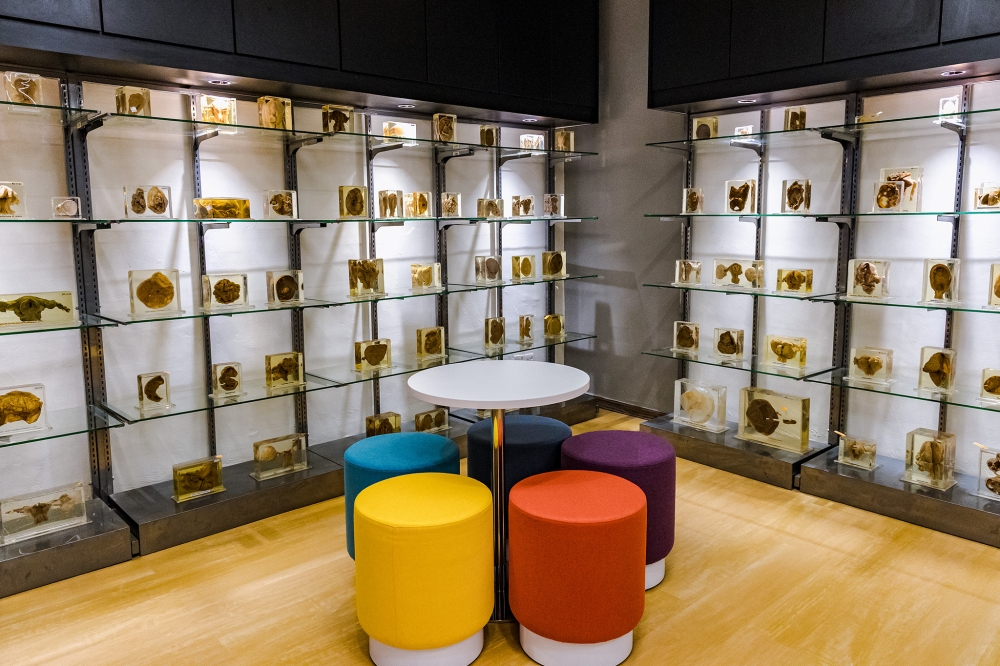
A room for students to examine and study the parts up close. — Picture by Firdaus Latif
“My passion for lifelong learning, promoting healthy living, and advancing healthcare drives me to support this cause. I am pleased to contribute towards the enhancement of this facility so that it can continue to educate and inspire future generations,” he told Malay Mail.
“I believe that health is the foundation for success both in business and in life, as without health we cannot work or contribute positively, and will become a liability instead.”
Lim believes that sustainable success rests on mental, physical, and financial health. Mental well-being, he says, is built through integrity and transparency. Physical health stems from what he calls the “Five Wells”: clean living, balanced eating, purposeful work, regular exercise, and restful sleep.
Only when these first two pillars are strong, he argues, can financial stability flourish. Beyond individual prosperity, Lim calls for corporate responsibility, urging industry leaders to invest in education, healthcare, and sustainability.
“Industry leaders should give back to society, it is an opportunity to create lasting positive change, because businesses grow alongside the communities they serve,” Lim said.
“Supporting education, healthcare, and sustainability helps build a stronger workforce and a healthier society, which benefits everyone in the long run. By leading with purpose, businesses can inspire others and contribute to a better future for all,” he added.
Meanwhile, UM’s Dean of the Faculty of Medicine, Professor Datuk Dr Yang Faridah Abdul Aziz, said the museum serves a purpose not only for the public but also for medical students. They have a separate room where students can hold and examine specimens up close.
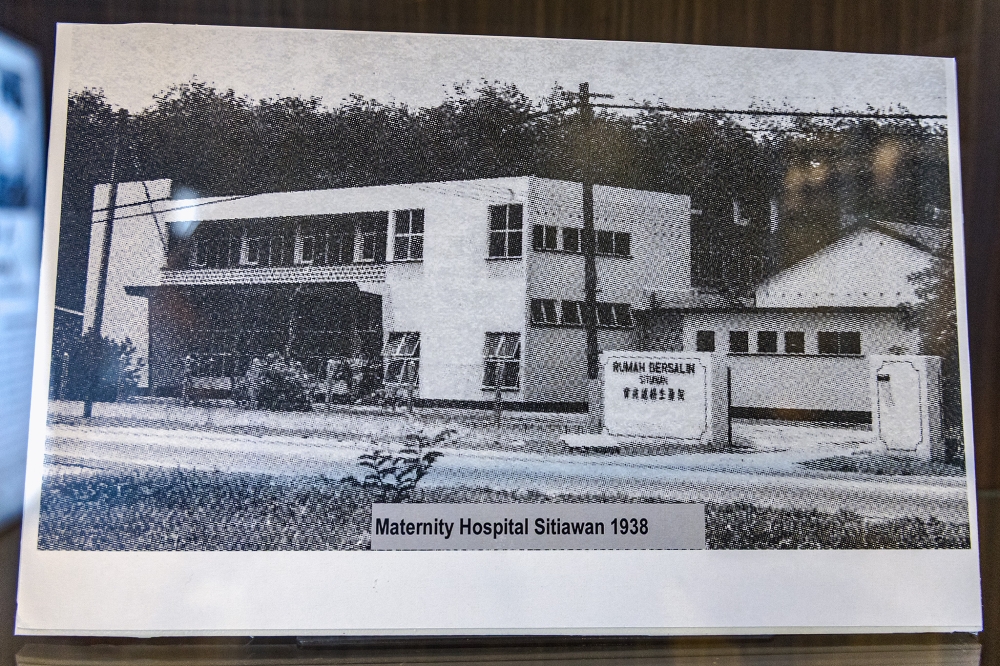
Pictures of old hospitals from the 1930's shows how far medicine has come. Right below the picture display are the old tools used for operating patients. — Picture by Firdaus Latif
“When we talk about teaching healthcare professionals, information should not exist in silos. You shouldn’t be learning the normal state of the diseased state at a different time, it creates a break in their thinking.
“We want to create healthcare workers who think holistically. Seeing the normal form side by side to a diseased state creates curiosity which is far more powerful than learning in isolation.
“In addition, knowledge should be shared. A place like this empowers individuals to understand their own bodies, own diseases and to make informed decisions about their health. If a young person comes here and sees this they may say, ‘Okay, I’m going to take charge of my health. I’m going to personalise my treatment, I’m going to be the decisions maker’. That’s the future of medicine,” she said when met.
Dr Yang said she hoped the museum would show how intricate the human body is and remind visitors not to take life for granted. The museum offers lessons from the past that give us knowledge to live better lives — and we should not squander it.
More than a medical display, the museum stands as a reminder of life’s fragility — and the power of knowledge to preserve it.
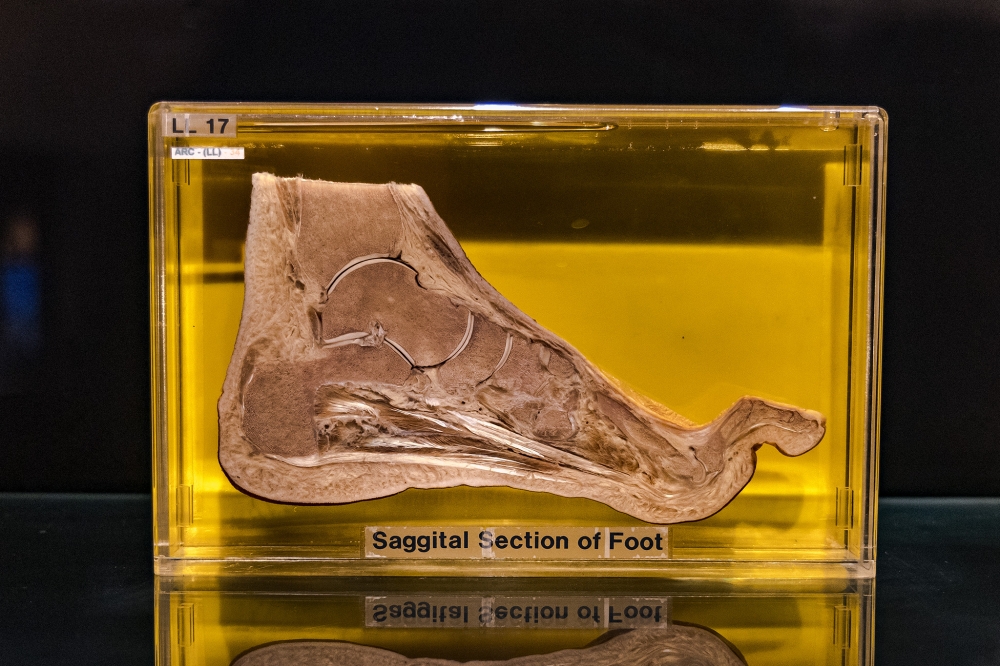
A section of a foot. — Picture by Firdaus Latif
The museum is open from Monday to Friday, 9am to 4pm. Last admission is at 3.30pm. Admission is free until May 31, 2025 and is accessible to wheelchair users. Email in advance if you are using a wheelchair so directions to a drop-off point can be arranged.
The recommended age for visiting the museum is seven and above. Children under seven must be accompanied by adults.
No photography or filming is allowed in the main exhibition area. This is to respect the individuals in the collections. However, photos may be taken at the museum counter, interactive learning area, the gallery, or in other zones without human specimens.
.png)

![Switzerland's Responsible Gun Culture (2019) [video]](https://www.youtube.com/img/desktop/supported_browsers/chrome.png)


